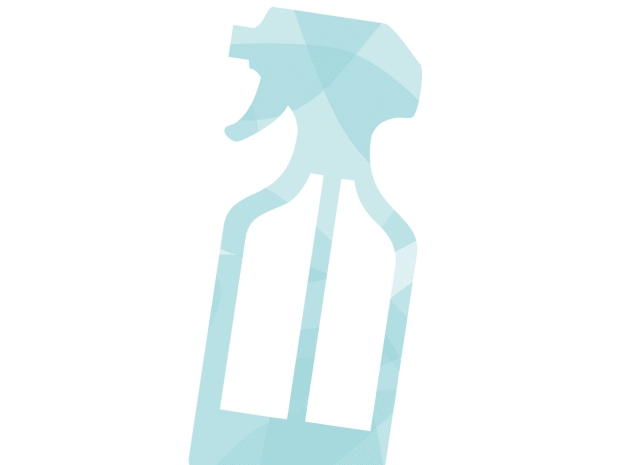
8 Best Sponges & Scrubbers for the Kitchen and Beyond
We've pulled the top 8 best sponges and scrubbers determined by Grove members. Select from any on the list and get them delivered to your door!
Read More


Last Updated: August 12, 2022
For people looking to reduce their paper waste, microfiber is a no-brainer alternative to traditional paper towels. But does washing microfiber present concerns for the environment and the ocean? Here’s what you should know.
Microfiber is a synthetic material used in many different products, including clothing, cleaning cloths, and sheets. Although synthetic fabrics are generally not considered environmentally friendly, microfiber cleaning cloths in particular have a complicated relationship with sustainability. They’re often touted as a green alternative to paper towels and single-use wipes — if you have microfiber cloths on hand, they serve as a handy alternative for less eco-friendly cleaners.
But does this admittedly excellent benefit of microfiber cloths outweigh the environmental damage they and other microfiber items may potentially do to the environment? Here, we get to the bottom of how microfiber may be impacting the environment with Grove’s own cleaning and sustainability experts.
Read more about how microfiber works and the best way to clean it in our Clean Team guide.
Microfibers are the tiny strands of polyester and nylon that make up microfiber cleaning cloths, bedding, or garments — including most things fleece. These fibers are up to 100 times finer than strands of human hair, and because of the sheer number of the tiny fibers found on microfiber cleaning cloths in particular, there’s a lot of surface area for dirt, bacteria, and other contaminants to cling to.
Watch this short video to see what microfibers look like and how they work:
Well, yes, according to the experts.
“Microfibers are essentially tiny pieces of plastic — they’re so small that they get into everything: plants, animals, soil, and water,” says Danielle Jezienicki, Director of Sustainability at Grove. “Collectively, every time we do the wash, the perpetual introduction of zillions of pieces of microplastic makes the microplastic problem worse. The stats are really alarming.”
Indeed, microfibers account for 85% of global shoreline pollution, and they’re responsible for a lion’s share of the microplastic pollution in our streams, rivers, oceans, and lakes. Microfibers have been found in 25% of individual fish and in 67 percent of all fish species in the U.S. — many of which are sold for human consumption.
But it’s not just the fibers themselves that animals and humans are ingesting. The enormous surface area of these countless microfibers attracts and absorbs large amounts of toxins — including pesticides, bacteria, and pharmaceutical drugs — that they come into contact with. Animals ingest these hazardous chemicals along with the fibers themselves, and then humans ingest them when they eat those animals.
Grove Tip
Studies have found that a single microfiber garment can shed more than 1,900 fibers per wash.
One way to help prevent microfiber pollution from entering waterways is to wash microfiber items only when you really need to.
Lead Grove Guide Angela Bell is a big fan of washing microfiber much less frequently than most people do. “When it comes to activewear, people launder workout clothes way more often than they need to, since they’re usually worn for an hour or less at a time.”
Depending on the intensity of your workout, says Bell, “workout clothes can often get a few uses before laundering—just hang them to let them air out between uses.”
She also keeps a natural spot cleaner and an enzyme-based stain remover on hand to tackle minor mishaps. “This allows me to embrace my mess-prone life yet still look fresh without washing the entire garment,” says Bell. “I just spray it onto the stain, allow it to sit for a few, and blot clean with a wet cloth.”
Jezienicki stresses that how you do laundry goes a long way toward increasing or reducing the number of microfibers that get shed on laundry day. She offers the following tips for microfiber pollution solutions.
Use the shortest cycle and the lowest spin setting to keep more microfibers where they belong, and fill up that drum with clothes and microfiber cloths — when fewer clothes are in the machine, they have more room to rub against one another and create friction, resulting in more fibers shed per load.

Powdered laundry detergents “scrub” clothes and dislodge more microfibers. Use a mild liquid laundry detergent, and wash in cold water.
“Heating water for laundry has a big carbon footprint, and effective cold-water laundry detergents, like Grove’s, makes it easy to turn down the temperature,” says Jezienicki, noting that the heat itself damages the microfibers and causes them to shed more.

To keep your microfiber items in good condition so they shed less, dry them on a “delicate” or “gentle” cycle with a low heat setting. Better yet, hang your microfiber to dry, which will keep them in better shape so they shed less in general. If you use the dryer, empty the lint trap into the trash after each load instead of washing it down the drain. And don’t use dryer sheets — they usually affect microfiber’s effectiveness.

A special tool to catch microfiber fibers before they leave your washing machine is best to use with all types of laundry. Below we have 3 recommendations for tools that are easy to install or use in any type of washing machine.
Jezienicki outlines three things you can do to reduce the number of microfibers your items shed in the laundry, in order of effectiveness:
A microfiber filter for the washing machine helps catch microscopic fibers shed from your synthetic laundry items before they can make it to the municipal drain.
Some washing machine microfiber filters attach to the discharge hose, while others float in the washing drum to catch microfibers before the water even leaves the machine.
A microfiber-filtering laundry bag is made of fibers that don’t break down. These bags filter out up to half of the microfibers your synthetics would otherwise have shed — and they’re great for protecting your delicates in the machine.
Says Jezienicki: “I always put workout gear, fleece, and other synthetics in my fiber-filtering laundry bag. It’s near zero hassle as long as you don’t overfill the bag — or your machine.”
A microfiber-trapping ball that floats in the drum of the washing machine, a Cora Ball is a softball-sized sphere with spines that are designed to prevent your sturdier clothes from getting snagged on it.
You can use more than one Cora Ball in each load to trap even more particles. Clean your laundry ball when it’s visibly coated with hairs and fibers.
Grove Tip
While microfiber items can’t be recycled into new products, you can donate microfiber clothes that are in good condition — or cut them into rags if they’re not.
Eventually, though, your microfiber products will likely end up in the landfill one way or another, so the best way to keep microfiber out of the environment is to choose natural fibers instead of synthetic whenever possible.

Wondering who Grove is, what types of products we offer, and how to get a free gift set when you sign up? Learn more about flexible monthly shipments, customizing your shipment, and joining millions of happy households — no monthly fees or commitments required.

We've pulled the top 8 best sponges and scrubbers determined by Grove members. Select from any on the list and get them delivered to your door!

We've pulled the top 10 most effective reusable dusters & dust pans determined by Grove members. Select from any on the list and get them delivered to your door!
We've pulled the 18 best natural Seventh Generation cleaning products that have been top-rated by Grove members. Select from any on the list and get them delivered to your door!

We've pulled the 8 best natural cleaning vinegar products that have been top-rated by Grove members. Select from any on the list and get them delivered to your door!